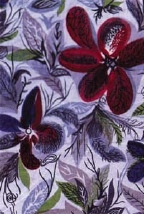Tea with Mr. Rochester
Tea With Mr. Rochester
Persephone Books
UK Paperback
ISBN: 1903155347
Pages: 184; Price: £10
Date Reviewed: April 2004
Reviewed by: Serena Trowbridge © 2004
|

Note: the covers of Persephone Books are gray
with a cream coloured title & author inset; the endpapers, different
for
each title,are seen in this image.
|
|
REFERENCES
|
COLUMNS
|
|
General Fiction
|
05-20-04
|
There are a number of British campaigns running at the moment to
"save our short story", since it is felt that the reading of short
stories is dying out. This may be true, but I am convinced that a
national reading of Frances Towers' Tea with Mr. Rochester could save
the story in an instant. The title itself has appeal: most women have
read Jane Eyre and been fascinated by Mr. Rochester, which is a good
start. The title story tells of a slightly melodramatic schoolgirl,
Prissy, with something of a crush on a teacher, who in her romantic
mind has assumed the aspect of Mr. Rochester. It is impossible to
read without a knowing smile to teenage years, and has literary
echoes that are delightful.
These stories pay no attention to fashion or trends; they are
about quiet, subtle observation and are some of the most beautifully
written short stories you are ever likely to come across. Her stories
have been described as being like oil paintings, and this is true:
she is a startlingly visual writer, describing rooms, people
(especially children), and situations with a clear, unsentimental
eye. Towers was a master of the short story format; however, the
afterword by Frances Thomas tells me that she was a reluctant writer,
who did not find writing easy. She wrote only the eighteen stories
collected here during her lifetime, and did not live to read the rave
reviews they received; and since there were no more forthcoming, the
reading public soon forgot about her.
The stories appear easy to read, but they sink slowly into your
thoughts, and have a particular gift for illuminating what we already
know in life - the little, daily observations Towers' makes are
unforgettable. I first heard her tale of office life - Don Juan and
the Lily - about a mysterious woman who keeps up a pretence despite a
miserable life, and the boss she fell in love with - on the radio
last year, and I find my mind keeps coming back to it. Some are quite
sinister - the tale of Violet, the perfect maid who harmlessly
insinuates herself into a household dominated by the mistress of the
house, and gets her own way, is almost eerie in its observation, and
in what it doesn't say, rather than what it does. And it takes a real
master of the art to achieve that.
She has been compared as a writer to Jane Austen, and indeed there
are similarities, with a social awareness and a gift for verbal
mimicry, not to mention a distinctly English tone at times. There is
also a brevity about her language, almost a terseness sometimes,
which is a blessed relief after some of the more verbose writers
around today.
The novel has endpapers with a design of small violets produced by
Humphrey Spender in 1949, which manages to be delicate and almost
pretty without being too pastel or sickly. This seems to sum up the
stories beautifully and is a perfect choice to offset this excellent
book.
